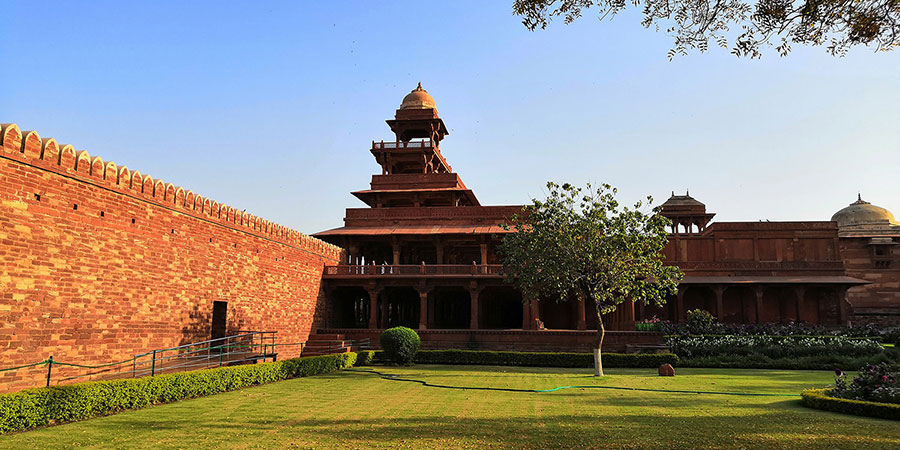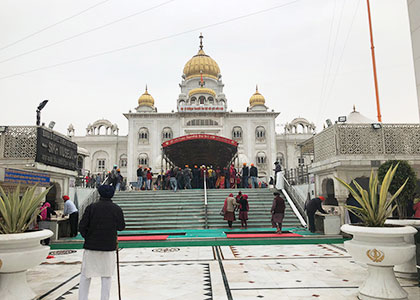Panch Mahal - A Brief Introduction to Mughal Entertainment Hall
Fatehpur Sikri is a gorgeous fortified citadel and the short-lived capital of the Mughal Empire. Commissioned by Akbar, the third Mughal ruler, the city served as the political capital of the dynasty for close to 15 years. The scarcity of water and other resources forced the emperor to shift his capital, while the beautiful city and its gorgeous palaces were left abandoned to retell the stories.Built just 40 kilometers (25 miles) away from Agra, Fatehpur Sikri is currently a favorite destination among tourists from all over the world. Built for red sandstone, the entire fortified complex has marvelous palaces, a stunning marble mosque, Mughal relics, and so on. Some of the interesting palaces of the citadel include Panch Mahal (Five-level Palace), Diwan-E-Khas (Hall of Private Audiences), Daulat Khana (Abode of Fortune), Khwabgah (Dream House), and Ibadat Khana (Prayer Hall).
Each of these pavilions and palaces was used for hosting specific state and private functions. Among these quarters, the Panch Mahal was used for entertainment and recreation. Build in the style of a Buddhist temple – the recreational palace surely stands out in the myriad crowds of palaces spread across Fatehpur Sikri. Let’s look into this interesting monument, and learn about its interesting history.

Panch Mahal of Agra
|
Panch Mahal – the recreational palace of the Mughals
The five-level palace or Panch Mahal was an important section of the Fatehpur Sikri. Commissioned by Emperor Akbar, the palace was used for entertainment and recreational purposes. Undoubtedly it was one of the most important sections of Fatehpur Sikri. Historical records show that during the short stint of the city (Fatehpur Sikri) as the capital of the Mughal dynasty, several artists and performers came here to showcases their art.Structurally, the Panch Mahal resembles a Buddhist temple with multiple receding levels (decreasing in size as one approach the top), giving an asymmetrical look to the palace. The entire structure contains close to 176 columns – the ground floor has 84 columns, while the first, second, and third floors have 56, 20 and 12 columns in that order. At the highest level, a chhatri (an elevated dome-shaped pavilion) stands with the support of 4 columns.
During those days, the columns were used to hold jaalis or delicate screens that skillfully hide the women of the Zenana from the public eye. During the medieval period, royal women in India had to cover their faces in public to stay hidden from the public eye. The huge screens were hosted during gathering and family functions to separate these women so that they can enjoy the function without being seen by the men outside their family.
The five-storied palace opened up to a pool, the Anoop Talab, and an open pavilion meant for the musicians to perform. It is not that hard to visualize, musicians, assembling in the evening as the cool breeze flows. Women hidden behind screens laughing and giggling, while men listening to the musical ensemble. It must have been a royal life.
Other interesting quarters of Fatehpur Sikri
Fatehpur Sikri was built during the beginning of the golden period of the Mughal era. Akbar was among the earliest successful ruler of the dynasty, who was able to rule more than twenty years, expand his kingdom, and introduced several policies and reforms in the political arena.It is believed that Emperor Akbar during his reign visited a Sufi Saint named Shaikh Salim Chishti who lived close to the ridge of Sikri. The saint predicted that the ruler would be blessed with an heir, who will forward the Mughal lineage. After the prophecy was fulfilled, the ruler built a fortified city – Fatehpur Sikri – and declared it as the new capital of the Mughal India.
|
|
As one enters this glorious citadel, they are welcomed by stunning Indo-Islamic architectural marvels like the Buland Darwaza (Gateway of Victory), Diwan-i-Khas (Hall of Private Audiences), and so on. As you pass through the Buland Darwaza, you will pass a massive gateway built to commemorate Akbar’s victory over Gujarat.
Next comes into the eyesight is the stunning marble mosque and Salim Chisti’s tomb. These religious buildings are still in use and display the artistic bent of the Mughal rulers. Decorated with latticework and colorful mosaic, after entering these buildings visitors are filled with a wave of internal peace.
Next, visitors can move towards the nearby Diwan-E-Am (Hall of Public Audiences). The northeast entrance has a stunning courtyard and a well-manicured garden, meant for beautifying the structure. The building was used for a public hearing and engineered to create an echo system so that everyone could listen to the emperor.
Beyond the Diwan-E-Am, on the northern side of the Pachisi Courtyard is Diwan-E-Khas (Hall of Private Audiences) – the room for a private audience with the king. Although the structure has a quite humble exterior, its interiors are jaw-drop beautiful. Intricately carved stone columns give this building a stunning appearance. If historical records are to be believed than Akbar used to host debates among scholars.
Some other popular landmarks include:
• Pachisi Courtyard
• Queen’s quarters
• Daulat Khana (Abode of Fortune)
• Khwabgah (Dream House)
• Birbal Bhavan (House of ministers)
• Hiran MinarDaftar Khana (Record Room)
• Lower Haramsara
Things to remember while visiting Fatehpur Sikri
The entire complex is huge, so to cover all the important landmarks including the Panch Mahal, visitors would require close to half of the day. One can squeeze in half a day into their Agra tour itinerary to fully explore this fortified city.The private cars have to be parked near the Agra Gate entrance, one kilometer away from the actual structure.
How to reach:
The Fatehpur Sikri is located at Agra and is one of the most popular tourist destinations. Visitors can either take a cab or a bus from Agra. The State Government and private tour operators organize a half-day or one-day tour of the Fatehpur Sikri.Best time to travel:
Ideally, October to February period is ideal for a Fatehpur Sikri trip as the weather is at its best.Timings:
Sunrise to sunset (Daily)Entrance fee:
Rs. 10 (Indian and citizens of SAARC and BIMSTEC countries), Rs. 250 (foreigners).Children up to 15 years of age can enter free.





